The causative agents of pear and apple scab are close relatives, but a fungus from a pear will never spread to an apple tree, and apple scab will never spread to a pear.
Unlike apple scab, pear infection can overwinter not only in fallen leaves, but also on affected shoots. Infection begins even when the buds open.Therefore, scab appears on a pear earlier in the spring than on an apple tree.
But the ways to combat these diseases are the same.
What contributes to the development of scab on apple and pear trees
The development of the disease is always favored by cold, rainy weather in spring and rainy, cool summer.
In hot and dry summers, apple trees may not become infected with scab. Spores germinate on fruits and leaves only under certain conditions. The process itself and the degree of contamination depend on humidity and air temperature
Moreover, humidity is determined not only by rain, but also by dew at night. Therefore, for gardeners, scab damage to a tree is often unexpected, even in hot, dry summers, but with heavy dew.
The first signs of the disease
Characteristic black spots with a velvety coating do not immediately appear on the leaves. Initially, the disease on the leaves is noticeable in the form of indistinct, round, vague chlorotic spots. By this time, the fungus had already caused harm, beginning to destroy plant tissue.
After a few days, the spots acquire visible signs of dark spots with a characteristic velvety coating. Under favorable conditions, the fungus spreads throughout the entire crown.
Prevention of apple and pear scab
The tree crowns should be well illuminated by the sun and quickly blown by the wind in wet weather. This requires annual pruning of the crown. A well-lit and quickly blown apple tree crown is less susceptible to infection.
It is better to keep the trunk circles under black fallow throughout the entire growing season. This reduces the harmfulness of the scab.
Almost the only source of spring infection is fallen leaves affected by scab in the previous season.To protect your trees from disease, you need to carefully collect and embed all fallen leaves in the fall, dig up the rows and embed the leaves into the soil. On pears, not only the leaves should be destroyed, but also the shoots affected by scab.
If you find it difficult to dig up the ground, you can do things a little differently. Spray fallen leaves and tree trunks with a 7 percent urea solution (700 grams per bucket of water), this spraying effectively destroys the infection.
To prevent scab on apple and pear trees, it is useful to spray the trees with the drug agate - 25 K (3 grams per bucket of water). This spraying should be done during bud break. It should be noted that the process of bud break is very short, only 2 - 3 days. Therefore, you need to prepare for processing in advance in order to do everything on time.
How to treat apple and pear scab
If the disease is just beginning, or is mild, you can treat the apple trees agate - 25 K or zircon.
Treatment with Bordeaux mixture
The most famous and proven method of treating apple and pear scab is Bordeaux mixture. The effect of Bordeaux mixture lasts up to two weeks, so 6-7 treatments have to be done in one season.
The very first spraying is done before the buds open. (Dilute 300 g of copper sulfate, 350 g of lime in a bucket of water)
Subsequent treatments are carried out every two weeks. The concentration of the solution is made weaker (100 grams of copper sulfate, 100 grams of lime per bucket of water). Bordeaux mixture can be replaced with any other copper-containing preparation.
Treatment with systemic drugs
Speed In one season, it is permissible to do two treatments with this drug. Treatments are carried out at intervals of 2 weeks, before flowering and immediately after flowering (2 ml per 10 liters of water). The drug retains its effect for 20 days.
Strobe. "Strobi" is used to treat apple and pear scab, and powdery mildew. Over the summer, up to 3 treatments can be carried out, the interval is 2 weeks. The duration of the drug is 35 days. The use of "Strobi" can be combined with other fungicides.
Horus. The drug is effective at low temperatures + 3 - 10 * C, and is not washed off by rain. Treatments are carried out twice per season, at bud break and at the very end of flowering. Validity period: 30 days.
Treatment with mineral fertilizers
You can treat scab with min. fertilizers In this case, simultaneously with treatment, foliar feeding of plants is carried out. Trees are sprayed with a solution of any of these fertilizers:
- ammonium nitrate, concentration 10%
- ammonium sulfate, concentration 10%
- potassium chloride, concentration 3 - 10%
- potassium sulfate, concentration 3 - 10%
- potassium nitrate, concentration 5 - 15%
- potassium salt, concentration 5 - 10%
Complex treatment
For best results, you should take a holistic approach to treating scab.
To do this, trees are treated in the fall with one of the mine solutions. fertilizers (as described above). Treatment is carried out after harvesting, before leaf fall. The air temperature should not be lower than +4*C. This will help destroy other pests and also increase the yield of the apple tree.
In the spring, before flowering, trees and tree trunks are sprayed with Bordeaux mixture (or any other copper-containing preparation).
After flowering, the trees are sprayed with some kind of fungicide (strobi, quick) or any other.
To make garden care easier, select varieties of apple and pear trees that are resistant to this common disease.
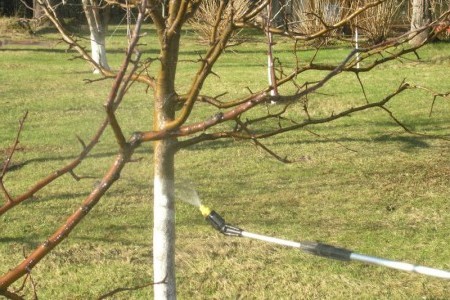
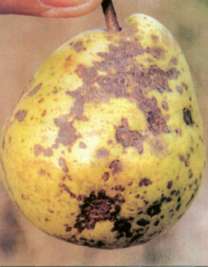
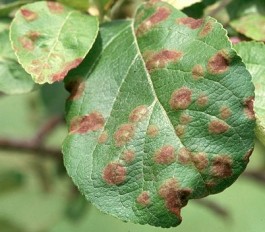
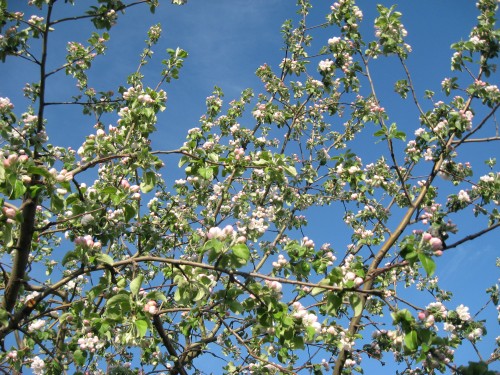

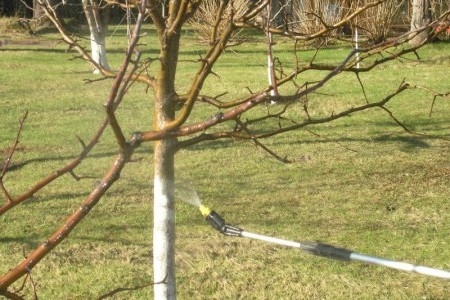

 (20 ratings, average: 4,40 out of 5)
(20 ratings, average: 4,40 out of 5) CUCUMBERS NEVER GET SICK, I'VE BEEN USING ONLY THIS FOR 40 YEARS! I SHARE A SECRET WITH YOU, CUCUMBERS ARE LIKE THE PICTURE!
CUCUMBERS NEVER GET SICK, I'VE BEEN USING ONLY THIS FOR 40 YEARS! I SHARE A SECRET WITH YOU, CUCUMBERS ARE LIKE THE PICTURE! You can dig a bucket of potatoes from each bush. Do you think these are fairy tales? Watch the video
You can dig a bucket of potatoes from each bush. Do you think these are fairy tales? Watch the video
 How our fellow gardeners work in Korea. There is a lot to learn and just fun to watch.
How our fellow gardeners work in Korea. There is a lot to learn and just fun to watch. Eye trainer. The author claims that with daily viewing, vision is restored. They don't charge money for views.
Eye trainer. The author claims that with daily viewing, vision is restored. They don't charge money for views. A 3-ingredient cake recipe in 30 minutes is better than Napoleon. Simple and very tasty.
A 3-ingredient cake recipe in 30 minutes is better than Napoleon. Simple and very tasty. Therapeutic exercises for cervical osteochondrosis. A complete set of exercises.
Therapeutic exercises for cervical osteochondrosis. A complete set of exercises. Which indoor plants match your zodiac sign?
Which indoor plants match your zodiac sign? What about them? Excursion to German dachas.
What about them? Excursion to German dachas.
Thank you. Very useful article. Especially for those who have an old garden.
I am very glad that the article was useful to you. Come visit us again.
My garden is still young. Today I examined the pears. The bottom of the trunk looks like scales from the bark. Is this scab? Maybe I need to scrape the trunk down to clean bark? - Or will there be wood there already?
Lyudmila, don’t worry about your pear. All pears eventually develop such “scales” on the trunk; this is normal.
Good article. I have a question. Light spots appeared on some pear leaves. They don't look like scab, but last year some of the fruits were cracked. Maybe it’s still a scab, and the spots will darken later? I can show you a photo of the leaves.
Olga, it is very difficult to make a diagnosis in absentia. Many pear diseases begin with spots on the leaves. It doesn't look like scab, but rather the tree is affected by rust or gall mite.
The pear has bright orange spots on the leaves above, and multiple black spots below. On the leaves of old shoots and on the leaves of young shoots. Treatment with the drug rayek did not give any results. What could it be? But it’s clearly contagious, since it started on a young pear, and then spread to the old Lada?
Galina, most likely your pear is affected by rust.Do you or your neighbors happen to have juniper growing? If it grows, it will be very difficult to get rid of this disease. We have juniper on our site and there was a pear tree that was always affected by rust. I couldn’t cure it, I had to cut it down. In a couple of years I will plant a pear tree that is resistant to this infection.
In apple trees, 1-2 large branches directed to the east begin to dry out, and the remaining branches are normal, with a large number of apples. In general, the apple trees are already old and, apparently, require anti-aging pruning? But why are the branches directed to the east?
Stalin, I think that old branches dry up only because they are old. It is unlikely that there is any connection with the cardinal points. Such apple trees really need anti-aging pruning. I have done this kind of pruning for many trees in my garden. If you are interested, you can look at this article:http://grown-en.tomathouse.com/pruning-apple-tree-video/ at the end of this article I described in detail how to do anti-aging pruning.
Tell me, please, what can I spray on a pear if there are already fruits?
Julia, when there are already fruits on the tree, it is not advisable to spray it with anything. Well, if the scab is really rampant, then spray with 1% Bordeaux mixture or Hom, copper oxychloride, colloidal sulfur. Only then wash the pears well.
Please help save the old pear tree. She is 55 years old, very tall, very beautiful, I love her very much, old variety Alexandrinka. Severely affected by scab, it is impossible to treat the crown due to its height. The trunk is strong, without lesions. A garden within the boundaries of an industrial city.Maybe there are drugs that can be used to treat through the root system? Junipers deliciously “eat” young pears - my mistake, but the old one is clearly scabby.
Lyudmila, unfortunately, scab on a pear can only be treated by spraying the diseased tree with some kind of fungicide. Tall trees can also be sprayed. To do this, you need to extend the hose on the sprayer and tie the sprayer to a long rail. There is another option, but it is more drastic and labor-intensive. Since the tree is so old and tall, it’s time for it to undergo anti-aging pruning (if your hand rises) You can see how to do this HERE. In this article I wrote how to prune apple trees, but such pruning is applicable to any fruit trees.
Thank you very much for your attention!!! I didn't even expect it. Very nice. You are right - your hand will not rise :) But the pear does not require pruning: it is still growing powerfully. The branches die off from below little by little - she regulates it herself. I doubt whether to lengthen the nozzle... The height of the pear is about 20 m. I’ll have to remember my younger years in my late 70s and climb up the trunk. This terrible year, spring frosts hit the garden: cherries and apricots disappeared, the rest need to be treated... Good luck to you in everything!
Please tell me, this year almost all the young apple and pear trees in the garden have become infected. What is the best way to treat them in the fall? whatever would help as much as possible. Thank you
Anatoly, in September, treat diseased apple and pear trees with a 7% - 10% urea solution.Such spraying will destroy scab spores on the trees (along with the leaves, but this is no longer scary), and in the spring before flowering it is still necessary to treat the trees with Bordeaux mixture.
Thank you, maybe it’s worth additionally fertilizing the root with superphosphate? And is it worth mulching the ground around the tree (with wood chips, pine needles, pine bark) if there is a suspicion that the soil is acidic (horsetail grows)?
Fertilizing with superphosphate in the fall, as well as any potash fertilizer, will only benefit the trees. Mulching the tree trunk circles is also highly desirable, BUT if the soil is acidic, under no circumstances mulch with pine needles. Needles greatly acidify the soil, I learned this from my own bitter experience. Use grass and straw for this. But it is necessary to remove fallen leaves from under scab-affected apple and pear trees even after treatment with urea. Scab spores overwinter in leaves, diseased fruits and affected tree branches.
Hello! Tell me, we have only one pear left in our garden, but it is heavily infected with scab (the plot was not ours, now I’m trying to revive it). The pear is all dry, but it bears fruit very well! It was all covered with pears. How can you revive her? It looks terrible, but I'm afraid that another pear won't take root! And can you tell me how to cut off the crown of apple trees? And what varieties of pears and apple trees are resistant to scab. We have a pond nearby, so scab is our strong enemy!
Irina, right now treat the pear with Bordeaux mixture or Horus for scab; (according to the instructions) spray not only the crown, but also the ground around the tree. At the end of flowering, repeat the treatment.Cut out all dry and diseased branches, remove all last year's leaves and fruits. Be sure to thin out the crown; it should be well ventilated and illuminated by the sun. It is important! Old trees require rejuvenating pruning. I always carry it out in two or three stages. In the first year I cut off half or a third of the crown, and after 1 - 3 years I cut out the remaining branches. This is less painful for the trees and there is no interruption in fruiting. Read more about this in this article: http://grown-en.tomathouse.com/rejuvenating-pruning-old-trees/ Apple trees resistant to scab: Aelita, Bogatyr, Rassvet, Fairy, Kulikovskoye, Buninskoye, Welsey, Anniversary of Moscow. Pears: Rusanovskaya, Botanical, Marble, Memorable, Rosy, Memory Parshina. When choosing seedlings, consider not only disease resistance, but for which area this variety was bred.
Is it necessary to pick off scab-affected leaves on an apple tree seedling?
There is no need to pick off affected leaves.
I have a question: I planted a pear seedling in the spring, leaves and shoots began to appear, but the problem is that for some reason the next young leaves began to turn red, first along the edge of the entire leaf, then the entire leaf turns red......what could this be, what is the reason for this phenomenon? Thank you.
Tatyana, there may be several reasons for this. Maybe groundwater is close, or the seedling was buried too deep during planting. Check if the root collar is in the ground, then the seedling must be dug up and raised so that the root collar is at soil level. Well, the tree may simply be sick with something, then in this situation it can hardly be helped.
Hello, please tell me there is a sweetish sticky liquid on pear trees, what should I do?
Read the article on your website “How to get rid of garden ants using folk remedies” and do not distract people from work.
Powerful seedlings grew from the pear seeds, but the leaves began to turn black around the edges. What is this? and how you can get rid of them.
And also, will these pears remain as tasty and large as I bought them in the store? or will they turn into wild animals?
Good afternoon, Nina. Unfortunately, I cannot answer your question why the leaves on pear seedlings turn black. There can be many reasons. Seedlings grown from seeds and seeds do not inherit parental characteristics. The fruits on the grown pear will be different from those from which you took the seeds, and most likely for the worse.
It would be a pity if the fruits turn out to be different in taste and quality than the purchased pears, from the seeds of which such beautiful seedlings grew
I will wait for the harvest; Otherwise, the locals produce fruits that look like flour, there is no juice in them at all and they are very small.
Thank you for your reply.
P.S. but I read on the Internet that such seedlings from seeds retain the qualities of their parents.
I had so much hope, but you scattered my hope to the wind.
Well, okay, let's see what the result is, then I'll report back.
With respect N.